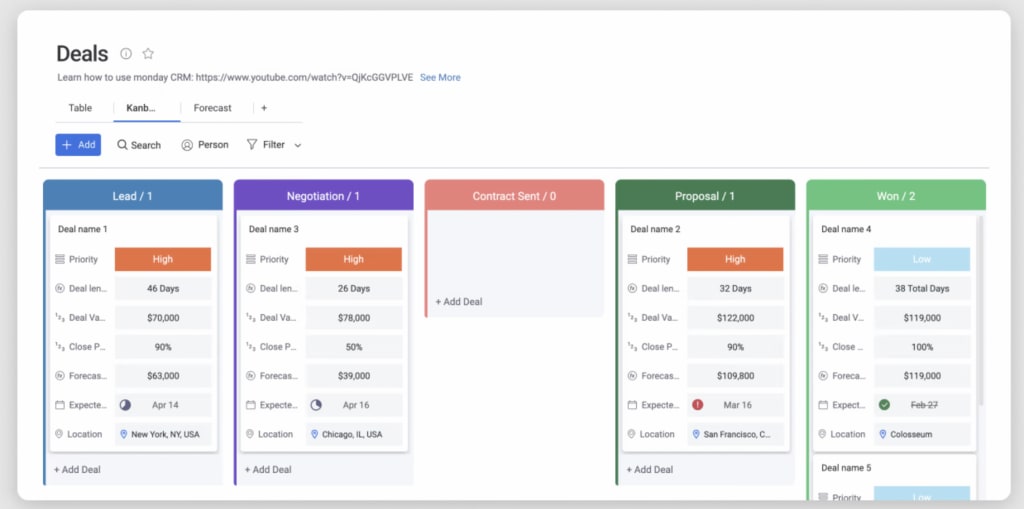There’s a lot that goes into successful sales operations. You need to establish a specific sales pipeline, capture new leads and nurture them through the pipeline, and then work on converting them into sales.
There are many different ways to capture and nurture leads, but in order to remain organized and really foster each and every lead by turning it into a relationship, it’s important to divide and conquer. That’s where sales territory management comes in.
By carefully analyzing customer data, sales teams can create territories that allow them to maximize their resources and maximize their sales. In this article, we’ll cover some of the benefits of territory management, walk you through how you can set one up yourself, and how to use work tools like monday.com to better manage territories. Let’s dive in!
What is sales territory management?
Sales territory management is the practice of managing the assignment of sales representatives to geographic areas, accounts, and customers. It involves dividing a company’s sales efforts into logical territory segments to ensure sales coverage and maximize sales performance.
The goal of sales territory management is to maximize the effectiveness of the sales force by optimizing the sales coverage of the target market.
Territory management involves identifying and defining the boundaries of each sales territory, assigning sales representatives to those territories, and monitoring their performance.
The benefits of sales territory management
By leveraging sales territory management, organizations can improve their overall sales performance and increase their bottom line. Here are a few of the benefits of sales territory management:
- Accurately cover sales areas by defining them and managing resources
- Improved customer service by enabling sales reps to focus on specific customers and prospects in their territory
- Maximize your sales reps’ time by helping them prioritize activities, stay organized, and easily track progress
- Better forecasting by allowing sales reps to understand their territories better and identify trends
- More precise customer segmentation and targeting by enabling sales reps to better understand their customers and focus on the right ones
- Strategically balance workloads according to sales cycle length, travel time, sales rep skills, resources, and more
Setting up a sales territory in 6 steps
Setting up a sales territory can be a difficult and time-consuming task. However, mapping out your sales territories and creating a plan for sales reps is an important step in optimizing your sales operations. Here are a few steps to take to create your own structured sales territory that will help your sales team succeed
1. Define your market
Before setting up a sales territory, it’s important to understand who your target customers are and what their needs are. This will help you determine where your sales territory should be located and what type of customers you need to target.
2. Research your competitors
Conduct research on your competitors and take note of their sales territories and strategies. This will give you a better understanding of how to effectively set up your own sales territory.
3. Analyze team resources
Evaluate your current team’s skills and availability and decide which areas you can serve with your current resources. Consider factors such as transportation costs, availability of personnel, and the size of your sales team.
4. Define sales territories
Once you have an understanding of your market, competitors, and resources, you can begin to map out your sales territories. You can use a geographic map to outline the boundaries of each territory and assign a sales representative to each one.
5. Develop a sales plan
After your sales territories have been set up, you need to develop a sales plan. An effective sales plan should include details such as goals, tactics, and strategies. It should also include an action plan that outlines specific tasks that need to be completed in order to reach your goals.
6. Monitor performance
As your sales team works on their individual territories, it’s important to regularly monitor performance and adjust the strategy as necessary. This includes tracking customer feedback, sales figures, and other metrics to ensure the territory is reaching its potential. monday.com can help you monitor territory sales and help you gather insight into sales rep performance.
Manage sales territories with monday.com
Creating sales territories on your own can be a lot of work, no matter the size of your team. Luckily, with the right work tools, you can make each step of this process a little easier. Tools like monday.com allow you to work on each step of creating a sales territory separately so that it’s optimized and efficient before moving on to the next one. Additionally, you can invite partners or your sales team to collaborate on the process, allowing them to be involved in establishing sales territories.
Let’s look at a few ways that monday.com can help you create, manage, and maintain a sales territory plan.
Understand your customers

By acting as a CRM, monday.com allows you and your team to gain a deeper knowledge of your customers, an essential first step in creating sales territories. By filtering leads and customers by the stage they’re at in the pipeline, their location, or even the value of their business, you can establish balanced sales territories.
Sales plan templates

With ready-to-go sales plan templates available on monday.com, you can easily get your sales plan up and running once territories are established. Allowing your team to see all parts of a sales plan in one place is a good way to create a space where they can collaborate efficiently while also maintaining ownership and control of their specific tasks.
Monitor performance

Get a bird’s eye view on workloads as well as past and current performance with a performance monitoring system on monday.com. You can create a board that helps you track your sales reps’ performance, sales values, or closed deals so that you can easily see whether the territories you created are helping or if they need to be adjusted to better distribute the workload.
FAQs
How can you effectively manage and grow a sales territory?
Following the steps mentioned above will allow you to effectively grow and manage any sales territory. Make sure you’re also setting clear goals, focusing on building customer relationships, working on a sales strategy, and regularly monitoring your sales team’s performance.
How do you divide sales territories?
Dividing sales territories can depend on a number of different factors, such as geographic location, the strengths of individuals in your sales team, or other resources. In general, you want to establish parameters that make sense for your organization and then assign territories accordingly.
How do you create a sales territory plan?
By going through the steps mentioned above and gathering information on your customers and territories, you can build a custom sales territory plan. Make sure to gather accurate data so that your plan is based on concrete information, and regularly monitor results to look out for any change in data, which could indicate your sales territory plan needs adjusting.
A reliable way of managing sales territories
Sales territory management is an essential tool for any business, regardless of size. It provides an organized approach to defining and managing territories that can help drive sales, maintain customer loyalty, and increase efficiency. When it comes to sales territory management, having the right tools in place is critical to the success of your sales plan and your reps. With work management tools like monday.com, the potential for increased sales, profitability, and a successful sales territory management plan is huge.

